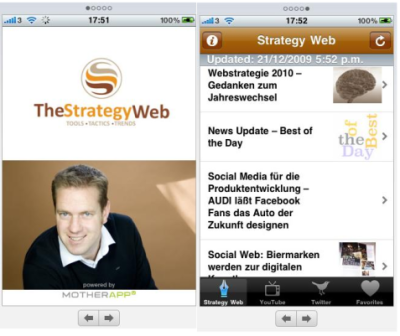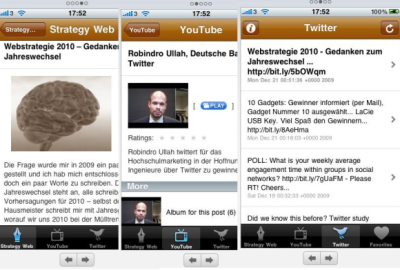eblizz – the next social shopping extension
 In the last four weeks, some of the users of The Strategy Web might have seen a small icon on the right hand side of my blog called ‘SocialSpace’. You might have wondered what it is. Or how to use it. Here comes the answer. Now, that the team around the eblizz founders, Jeanette Okwu and Martin Wawrusch, has completed the integration of the social software tool, I will introduce you to a technology that I would call the next social shopping extension for future business.
In the last four weeks, some of the users of The Strategy Web might have seen a small icon on the right hand side of my blog called ‘SocialSpace’. You might have wondered what it is. Or how to use it. Here comes the answer. Now, that the team around the eblizz founders, Jeanette Okwu and Martin Wawrusch, has completed the integration of the social software tool, I will introduce you to a technology that I would call the next social shopping extension for future business.
Social networks are on an all-time high. Corporate websites and shops loose out on traffic and referential linking as people start talking, connecting and linking via social networks like Facebook, Twitter or other social networks. SEO doesn’t work here as closed front doors don’t allow access for SEO tactics. And with the massive rise of social networks, especially Facebook, the question comes up how to bridge the lack of a connection between social networks and homepages or shops.
eblizz offers this solution. It brings social networks and brands together. In a way that social Networks become an integral part of brand websites – be it homepages, shops or blogs. For now, eblizz starts with Facebook – but Martin told me, other networks will follow.
With eblizz users can interact with their social networks without leaving branded sites. Content can be shared with friends on Facebook. Users can immediately comment from the website they are on. Or store products visually in ‘The Shoebox’ and keep it for later purpose or use. Content can be, or as eblizz calls it, has to be ‘liberated’
What is the benefit of eblizz?
Business perspective Think about it. Prosumers create masses of content on the social web. Consuming that content, prosumers realize that brands become more and more exchangable. This causes problems for companies. They need to increase efforts to make their brand get heard. So ideally, companies make use of recommendation marketing to use the buzz of their brand fans.
User perspective Consumers often find things like nice products in online-shops. Or great music. Or funny videos. Or great pictures. And they want to recommend this to friends they are connected with on social networks. Today, it is impossible to take your friends from homepage to homepage, and easily share that content via a social network with one click.
Imagine your Facebook friends follow you from website to website. And, when you want to recommend something to them, you don’t have to change browser windows. You don’t have to cut-and-paste content. You just drag and drop it to the relevant person. Watch the short explanation and tell me if this isn’t really cool…
Companies pay a fee to get their websites eblizzed – no matter if it is a shop, a homepage or a blog. Their sites will be defragmented like a cake. This makes it easy for prosumers to share and recommend relevant pieces of content of a website: videos, links, pictures, etc.
Once a site is eblizzed, users find a button called SocialSpace – the button I started talking about at the beginning. The user logs in with on the question-marked face with their social network account. The SocialSpace opens up in a small picture on the website they are on. The users see their profile, the friends and updates immediately. They can also search for friends. And, they can immediately interact with their social network friends.
Users can even ‘bookmark’ interesting content in their Shoe-Box. The Shoe-Box is a place for personal content belongings. Here the users keep very special things in their SocialSpace. Maybe to recomment or remember a product or present for a Christmas or birthday in the future.
eblizz offers a next generation website customer service. eblizz integrates social network interaction in companies websites. And eblizz will become the driver of social commerce efforts by enabling engagement and brand buzz.
“Prosumers” create masses of content on the internet, including blog posts, product reviews and ratings. Producing all that content, prosumers begin to blur the lines between brands, making them more interchangeable. Not good for individual brands. That’s why companies need to increase efforts to distinguish their brand from all the rest. One way is to capitalize on “recommendation marketing” — build the buzz created by their brand fans. eblizz can help.
And here is how it works…
Consumers often discover products that they love online. And great music, funny videos and awesome pictures. They want to recommend them to their social-network friends. Today, it is impossible to take social-network friends from homepage to homepage, and easily share that content via a social network with one click. This is a universal social web problem!
So, imagine your Facebook friends follow you from website to website. And, when you want to recommend something to them, you don’t have to change browser windows. You don’t have to cut-and-paste content. You just drag and drop it to the relevant person.
eblizz was created to make things easier for anyone who wants to recommend content, product and services to any or all of their social-network friends. Websites and blogs sign up to get “eblizzed”. The fee seems very reasonable. Once a site is eblizzed, a button appears on the site’s homepage called “SocialSpace.” When a user logs in with their social network account information, Facebook for example, the SocialSpace opens up into a small picture that displays the user’s Facebook profile, Facebook friends (and their pictures!) and updates that are happening on facebook right from the website the user is on. The user can then drag and drop anything from the website right onto the Facebook page of any or all of their Facebook friends.
The user can also ‘bookmark’ interesting content from the website by dragging into their “ShoeBox.” This content stays in the Shoe Box for the user’s later use, can be edited and also shared.
Spot On!
So for me, the reason for a website to get “eblizzed” is simple. eblizz integrates social network interaction for all the users who visit a website, making it easy for them to recommend and share the website’s content. That’s how eblizz helps companies distinguish their brands. What is your take on it? Maybe you want to test it with my eblizz SocialSpace button? Drag and drop me your best videos on advertisement, funny pictures, shopping tips or cool texts. Looking forward to it!
And sure, let me know what you think about eblizz…







